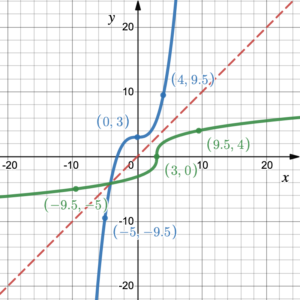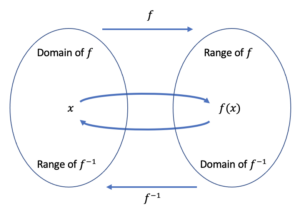Learning Objectives
- Determine if two functions are inverses of each other using the composition of functions
The Composition of a Function and Its Inverse
In the previous section we discovered that a one-to-one function has an inverse function, and that a one-to-one function and its inverse functions are reflections of one another across the line [latex]y=x[/latex]. This means that while the green curve in figure 1 is the inverse function of the blue curve, symmetry shows that the blue curve must be the inverse function of the green curve.

Figure 1. A one-to-one function and its inverse functions are reflections of each other across the line [latex]y=x[/latex]
In figure 1, if [latex]y=f(x)[/latex] is the blue curve, [latex]f(0) = 3[/latex] implies that [latex]f^{-1}(3) = 0[/latex]. This is confirmed on the green curve [latex]y=f^{-1}(x)[/latex]. In other words, if we find the function value at [latex]x=0[/latex] and get 3, then find the inverse function value at [latex]x=3[/latex], [latex]f^{-1}(3)[/latex], we get back to 0. The inverse function undoes the original function and we end up back where we started.
Logically, since [latex]f(x)[/latex] and [latex]f^{-1}(x)[/latex] are inverse functions of each other, [latex]\left (f\circ f^{-1}(x)\right )=f\left (f^{-1}(x)\right )=x[/latex].
Diagrammatically, 
Given a function [latex]f\left(x\right)[/latex], we can verify whether some other function [latex]g\left(x\right)[/latex] is the inverse of [latex]f\left(x\right)[/latex] by checking whether [latex]g\left(f\left(x\right)\right)=x[/latex] and [latex]f\left(g\left(x\right)\right)=x[/latex] are true.
For example, prove that [latex]y=4x[/latex] and [latex]y=\frac{1}{4}x[/latex] are inverse functions.
[latex]\left({f}^{-1}\circ f\right)\left(x\right)={f}^{-1}\left(4x\right)=\frac{1}{4}\left(4x\right)=x[/latex]
and
[latex]\left({f}^{}\circ {f}^{-1}\right)\left(x\right)=f\left(\frac{1}{4}x\right)=4\left(\frac{1}{4}x\right)=x[/latex]
test whether two functions are inverses of each other
- Determine whether [latex]f\left(g\left(x\right)\right)=x[/latex] and [latex]g\left(f\left(x\right)\right)=x[/latex].
- If both statements are true, then [latex]g={f}^{-1}[/latex] and [latex]f={g}^{-1}[/latex]. If either statement is false, then [latex]g\ne {f}^{-1}[/latex] and [latex]f\ne {g}^{-1}[/latex].
Example 1
If [latex]f\left(x\right)=\dfrac{1}{x+2}[/latex] and [latex]g\left(x\right)=\dfrac{1}{x}-2[/latex], is [latex]g={f}^{-1}?[/latex]
Solution
[latex]\begin{align} g\left(f\left(x\right)\right)&=g\left (\dfrac{1}{x+2}\right )\\&=\frac{1}{\left(\frac{1}{x+2}\right)}{-2 }&\text{The reciprocal of a reciprocal is the number: }\dfrac{1}{\frac{1}{a}}=a\\[1.5mm]&=({ x }+{ 2 }) -{ 2 }&\\[1.5mm]&={ x }& \end{align}[/latex]
and
[latex]\begin{align} f\left(g\left(x\right)\right)\\&=f\left (\dfrac{1}{x}-2\right )&=\frac{1}{\frac{1}{x}-2+2}\\[1.5mm] &=\frac{1}{\frac{1}{x}} \\[1.5mm] &=x \end{align}[/latex]
Therefore, [latex]g={f}^{-1}\text{ and }f={g}^{-1}[/latex].
Try It 1
If [latex]f\left(x\right)={x}^{3}-4[/latex] and [latex]g\left(x\right)=\sqrt[3]{x+4}[/latex], is [latex]g={f}^{-1}?[/latex]
If you had problems completing the Try It, the problem solution is detailed here.
TRY IT 2
Determine if [latex]f(x)=x-1[/latex] and [latex]g(x)=\dfrac{1}{x-1}[/latex] are inverse functions.
Example 2
If [latex]f\left(x\right)={x}^{3}[/latex] (the cube function) and [latex]g\left(x\right)=\frac{1}{3}x[/latex], is [latex]g={f}^{-1}?[/latex]
Solution
[latex]f\left(g\left(x\right)\right)=\left(\frac{1}{3}x\right)^3=\dfrac{{x}^{3}}{27}\ne x[/latex]
No, the functions are not inverses.
Analysis of the Solution
The correct inverse to [latex]x^3[/latex] is the cube root [latex]\sqrt[3]{x}={x}^{\frac{1}{3}}[/latex], that is, the one-third is an exponent, not a multiplier.
Try It 3
If [latex]f\left(x\right)={\left(x - 1\right)}^{3}\text{and}g\left(x\right)=\sqrt[3]{x}+1[/latex], is [latex]g={f}^{-1}?[/latex]
Candela Citations
- Revision and Adaptation. Authored by: Hazel McKenna and Leo Chang. Provided by: Utah Valley University. License: CC BY: Attribution
- Revision and Adaptation. Authored by: Hazel McKenna and Leo Chang. Provided by: Lumen Learning. License: CC BY: Attribution
- All Try Its and Examples. Authored by: Hazel McKenna. Provided by: Utah Valley University. License: CC BY: Attribution
- College Algebra. Authored by: Abramson, Jay et al.. Provided by: OpenStax. Located at: http://cnx.org/contents/9b08c294-057f-4201-9f48-5d6ad992740d@5.2. License: CC BY: Attribution
